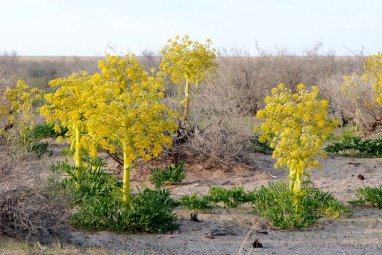
This year, the Gaplangyr State Nature Reserve celebrates 45 years since the start of scientific activities in the study of flora and fauna.
The reserve is located in the northern part of Turkmenistan. It was created to protect and restore the number of goitered gazelle, honey badger, and Ustyurt mountain sheep in 1979, according to the “Neutral Turkmenistan” newspaper.
Since last year, its territory has been part of the transnational site “Turan Temperate Deserts” on the UNESCO World Heritage List.
The protected area covers over 275 thousand hectares.
According to data from previous years, a small migratory population of kulan of up to forty heads lives within the reserve.
The reserve includes the Sarygamysh and Shasenem reserves, created to protect waterfowl and semi-aquatic wintering, nesting and migratory birds, as well as ungulates.
Gaplangyr is a bird's “Eldorado”, where there is a rich diversity of sedentary, migratory, wintering, especially wetland and predatory species.Here you can observe a kestrel, a marsh harrier, a steppe eagle, and with the help of powerful optics you can see rare species of pink and Dalmatian pelicans and gulls on the islands of Lake Sarygamysh remote from the shore.
The rare lapwing sandpiper and flamingo also stop here during migration.
Within the reserve and outside its borders there are remarkable natural objects, hydrological, karst and landscape monuments. One of them is a pointed ridge with steep sides, layers of sandstone and gypsum called Burçly burun, which has preserved traces of ancient settlements.
Another remarkable object is the Mergen Ishan gorge, six kilometers long, 15 to 70 meters wide and with steep walls up to 35 meters high - one of the amazing creations of the ancient Amu Darya.
The sandy bottom of the gorge is overgrown with combs and shrub vegetation, including a relict plant - the soft-leaved cranberry (“Turkmen cranberry”).This small ecosystem has become a habitat for birds and small animals, nesting sites for the “Red Book” eagle owl, chukar chukars, house eagle, and kestrel.
Porcupines and badgers hide in burrows here, wolves, wild boars and foxes run in to warm up and feed themselves. In summer, reptile activity is noticeable, and several species of reptiles have been recorded.
The hydrological object of the Gaplangyr steppes with small vegetation cover is the Zengi Baba depression, which during its history filled with water and dried up.Its last watering was associated with the intensive agricultural development of the Shasenem massif in the last century.
The water area of the lake is rich in fish - catfish, carp, and bream live here.
The man-made lake Uzynshor, as well as the Turkmen lake “Altyn Asyr” adjacent to the western border of the reserve, enhance the factor of watering the steppes, creating favorable conditions for the existence of the unique biodiversity complex of Gaplangyr.
